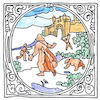Johannes Trithemius
cryptography

|
Steganography
Johannes Trithemius claimed that Jerome said that many mysteries, intended for only the most learned philosophers and poets, lay hidden in the original Greek of the Apocalypse of John. In his Steganographia Johannes Trithemius wove a hundred forms of secret writing into a three-volume treatise about how to use angels to communicate over long distances.
Early forms of hidden writing
A message written under hair on the scalp, a message written under the wax of a writing tablet, a code of knots knit into a garment, invisible ink. Take the first letters of every line. Take the first letters of every word. Take the first letters of every other word. Take every other letter of every other word. Assign a letter to Latin adjectives used in prayers and sprinkle them into an invocation. Reverse the alphabet, assign numbers to each letter, and disguise your message as astronomical data.
As for why
As for why Trithemius concealed his methods for concealing secret writing in a treatise on communicating with angels, well, he felt that although good and honest men could use his methods for the common good the perverted and impious would use his methods to aid their crimes, apparently believing that only good men were smart enough to discover his keys.



Steganography is a form of cryptography that can be combined with ciphers, codes, and encryption. These terms are often used loosely; however, it can be useful to give them distinct meanings. Steganography is a means of hiding a message; a cipher is a one-to-one alphabetic substution; a code is a one-to-many substitution such as binary or Morse code; encryption uses a mathematical scheme to disguise any digital message.
See also in The book of science:
Readings in wikipedia: